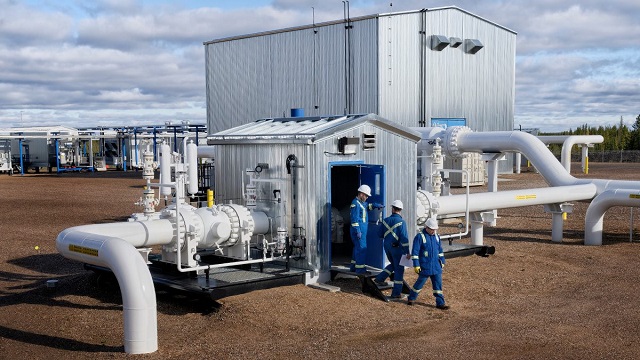Alberta
New $1 billion pipeline deal spreads Indigenous ownership through Alberta, B.C. and Saskatchewan

From the Canadian Energy Centre
By Will Gibson
‘We are writing the history of tomorrow today, not living the outcomes of our forefathers’
In a landmark agreement announced July 30, a consortium of up to 72 Indigenous communities in Alberta, British Columbia and Saskatchewan will buy a 5.34 per cent stake in TC Energy’s NGTL natural gas network.
The agreement is backed by a $1 billion loan guarantee from the Alberta Indigenous Opportunities Corporation (AIOC).
TC Energy’s sprawling NGTL network spans 25,000 kilometres and handles about 10 per cent of North America’s natural gas, connecting production in Alberta and British Columbia to domestic and export markets.
The loan guarantee has similarly impressive scope and size, quadrupling the AIOC’s previous largest financial commitment, a $250 million loan guarantee provided to 23 Indigenous communities in September 2022 to help purchase an 11.57 per cent stake in seven Enbridge oil sands pipelines in northern Alberta.
The deal will raise the AIOC’s support of Indigenous equity ownership in resource projects to over $1.68 billion since 2019.
“I’ve participated in three of these transactions, including the Enbridge loan guarantee, and you can see an evolution in the size and complexity of these agreements,” says Justin Bourque, founder and president of Âsokan Generational Developments, a consultancy that specializes in partnerships between Indigenous communities and industry.
“They are building on the good work from previous deals and it’s wonderful to see the AIOC expanding into neighbouring provinces, where these types of agreements will have significant benefits to the participating Nations in B.C. and Saskatchewan as well as Alberta.”

Âsokan Generational Developments president and founder Justin Bourque pictured on his trap line in northern Alberta with the Long Lake oil sands facility in the background. Photo for Canadian Energy Centre
The new agreement also demonstrates growing comfort among Indigenous communities, industry players and lenders as these equity arrangements become more commonplace, says Heather Exner-Pirot, director of energy, natural resources and environment at the Macdonald-Laurier Institute, an Ottawa-based think tank.
“There are some formidable challenges with trying to negotiate with multiple communities across different treaty areas and provinces, but this shows the confidence the Alberta government has in backstopping these bespoke deals with communities and companies when the merits of the project deserves it,” says Exner-Pirot, who also serves as a special advisor to the Business Council of Canada.
“It also demonstrates the confidence from the lenders in these equity deals for pipelines. And that confidence is well founded because these existing pipelines are a stable business that generate the revenues to pay back the loan as well as income for the communities to use as well.”
The announcement builds on momentum for Indigenous ownership of Canadian energy projects, including June’s announcement that the Haisla Nation and Pembina Pipeline Corporation will move ahead with the Cedar LNG project.
The floating LNG export facility on Canada’s west coast will be the world’s first with Indigenous majority ownership.
Bourque sees the agreements providing a framework for future partnerships between Indigenous communities, government and industry beyond equity ownership.
“This is an important stepping stone in our evolution and it’s exciting to see it continue through pursuing opportunities in energy development, decarbonization and energy transition projects,” Bourque says.
“We are writing the history of tomorrow today, not living the outcomes of our forefathers.”
Exner-Pirot also sees a bright future for collaborations between Indigenous communities and energy companies, in part because the federal, Saskatchewan and BC governments now also offer loan guarantee programs.
“These deals take months, if not years, to come together and what this shows is the AIOC, Indigenous communities and energy companies have found a template that works,” she says.
“The NGTL loan guarantee is the biggest but it won’t be the last one.”
Alberta
Red Deer Justice Centre Grand Opening: Building access to justice for Albertans

The new Red Deer Justice Centre will help Albertans resolve their legal matters faster.
Albertans deserve to have access to a fair, accessible and transparent justice system. Modernizing Alberta’s courthouse infrastructure will help make sure Alberta’s justice system runs efficiently and meets the needs of the province’s growing population.
Alberta’s government has invested $191 million to build the new Red Deer Justice Centre, increasing the number of courtrooms from eight to 12, allowing more cases to be heard at one time.
“Modern, accessible courthouses and streamlined services not only strengthen our justice
system – they build safer, stronger communities across the province. Investing in the new Red Deer Justice Centre is vital to helping our justice system operate more efficiently, and will give people in Red Deer and across central Alberta better access to justice.”

Government of Alberta and Judiciary representatives with special guests at the Red Deer Justice Centre plaque unveiling event April 22, 2025.
On March 3, all court services in Red Deer began operating out of the new justice centre. The new justice centre has 12 courtrooms fully built and equipped with video-conference equipment to allow witnesses to attend remotely if they cannot travel, and vulnerable witnesses to testify from outside the courtroom.
The new justice centre also has spaces for people taking alternative approaches to the traditional courtroom trial process, with the three new suites for judicial dispute resolution services, a specific suite for other dispute resolution services, such as family mediation and civil mediation, and a new Indigenous courtroom with dedicated venting for smudging purposes.
“We are very excited about this new courthouse for central Alberta. Investing in the places where people seek justice shows respect for the rights of all Albertans. The Red Deer Justice Centre fills a significant infrastructure need for this rapidly growing part of the province. It is also an important symbol of the rule of law, meaning that none of us are above the law, and there is an independent judiciary to decide disputes. This is essential for a healthy functioning democracy.”
“Public safety and access to justice go hand in hand. With this investment in the new Red Deer Justice Centre, Alberta’s government is ensuring that communities are safer, legal matters are resolved more efficiently and all Albertans get the support they need.”
“This state-of-the-art facility will serve the people of Red Deer and surrounding communities for generations. Our team at Infrastructure is incredibly proud of the work done to plan, design and build this project. I want to thank everyone, at all levels, who helped make this project a reality.”
Budget 2025 is meeting the challenge faced by Alberta with continued investments in education and health, lower taxes for families and a focus on the economy.

Quick facts
- The new Red Deer Justice Centre is 312,000 sq ft (29,000 m2). (The old courthouse is 98,780 sq ft (9,177 m2)).
- The approved project funding for the Red Deer Justice Centre is about $191 million.
Alberta
Made in Alberta! Province makes it easier to support local products with Buy Local program

Show your Alberta side. Buy Local. |
When the going gets tough, Albertans stick together. That’s why Alberta’s government is launching a new campaign to benefit hard-working Albertans.
Global uncertainty is threatening the livelihoods of hard-working Alberta farmers, ranchers, processors and their families. The ‘Buy Local’ campaign, recently launched by Alberta’s government, encourages consumers to eat, drink and buy local to show our unified support for the province’s agriculture and food industry.
The government’s ‘Buy Local’ campaign encourages consumers to buy products from Alberta’s hard-working farmers, ranchers and food processors that produce safe, nutritious food for Albertans, Canadians and the world.
“It’s time to let these hard-working Albertans know we have their back. Now, more than ever, we need to shop local and buy made-in-Alberta products. The next time you are grocery shopping or go out for dinner or a drink with your friends or family, support local to demonstrate your Alberta pride. We are pleased tariffs don’t impact the ag industry right now and will keep advocating for our ag industry.”
Alberta’s government supports consumer choice. We are providing tools to help folks easily identify Alberta- and Canadian-made foods and products. Choosing local products keeps Albertans’ hard-earned dollars in our province. Whether it is farm-fresh vegetables, potatoes, honey, craft beer, frozen food or our world-renowned beef, Alberta has an abundance of fresh foods produced right on our doorstep.
Quick facts
- This summer, Albertans can support local at more than 150 farmers’ markets across the province and meet the folks who make, bake and grow our food.
- In March 2023, the Alberta government launched the ‘Made in Alberta’ voluntary food and beverage labelling program to support local agriculture and food sectors.
- Through direct connections with processors, the program has created the momentum to continue expanding consumer awareness about the ‘Made in Alberta’ label to help shoppers quickly identify foods and beverages produced in our province.
- Made in Alberta product catalogue website
Related information
-

 Business1 day ago
Business1 day agoIs Government Inflation Reporting Accurate?
-

 2025 Federal Election2 days ago
2025 Federal Election2 days agoConservatives promise to ban firing of Canadian federal workers based on COVID jab status
-

 2025 Federal Election1 day ago
2025 Federal Election1 day agoCarney’s Hidden Climate Finance Agenda
-

 Environment2 days ago
Environment2 days agoExperiments to dim sunlight will soon be approved by UK government: report
-

 International2 days ago
International2 days agoPope Francis Got Canadian History Wrong
-

 2025 Federal Election1 day ago
2025 Federal Election1 day agoStudy links B.C.’s drug policies to more overdoses, but researchers urge caution
-

 Censorship Industrial Complex2 days ago
Censorship Industrial Complex2 days agoIs free speech over in the UK? Government censorship reaches frightening new levels
-

 2025 Federal Election1 day ago
2025 Federal Election1 day agoWhen it comes to pipelines, Carney’s words flow both ways








